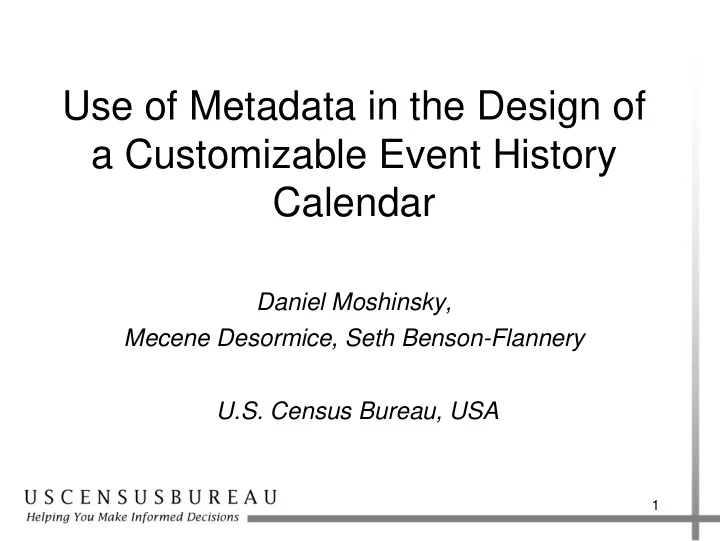

Use of Metadata in the Design of a Customizable Event History Calendar Daniel Moshinsky, Mecene Desormice, Seth Benson-Flannery U.S. Census Bureau, USA 1
Overview • Intro to SIPP and the EHC • SIPP EHC design requirements and considerations • Description of the design • Benefits and conclusions 2
What is SIPP? • SIPP = Survey of Income and Program Participation • Large, longitudinal survey that collects – Sources and amounts of income – Federal and state program participation – General demographics – …and other information 3
SIPP Re-Engineering Effort • In order to cut costs and reduce R. burden, interviews will be conducted once a year, instead of 3 times a year. • Reference period increased to 12 months of the past calendar year – from 4 months previously. • Event History Calendar (EHC) used to improve recall of events during this longer period 4
How data is collected • SIPP contains some 40 sections • About half of the questions are collected in Blaise 4.8 DEP – Mostly questions not involving specific dates (e.g. value of assets) • About half are collected in the EHC module – Questions involving recall of dates, changes in status (e.g. job changes, changes in residence) – Written in C# .NET, invoked from DEP as COM object DLL 5
Design Considerations • Data interchange throughout SIPP and data integrity – Parameters passed between EHC and Blaise sections (e.g., section in Blaise about how you commute to work uses employment data collected in the EHC) – Michigan’s early experiences with data quality when using a separate database for the EHC – Therefore, we decided that all data will be stored in a single Blaise DB 6
Design Considerations (cont’d) • Fluid requirements – EHC is a new format for the Census Bureau and SIPP, many sections and questions are being written from scratch and re-written – Requirements expected to change frequently as sponsors become familiar with the EHC – Thus, EHC must be flexible enough to accommodate changes quickly 7
Design Considerations (cont’d) • Large number of questions in EHC – 25 sections in EHC, some sections have many questions for each time period entered (e.g., about 40 questions for a reported time at a job) – Implementing layout of questions and answer lists, skip patterns, data access, and edit checks is very labor intensive outside of Blaise – Needed to minimize hard-coding of individual questions 8
Design Considerations (cont’d) • Maintenance and Re-use of EHC – It was important to design EHC so that it can be maintained and modified without substantial C# programming. – If EHC works well for SIPP, it may be adopted by other surveys – Thus, it’s a plus if SIPP EHC can be customized and re-used from survey to survey 9
Summary of requirements • EHC must – Be able to handle a large number of sections and questions – Be easy to maintain, modify, and re-use – Integrate seamlessly with the Blaise portion of the interview 10
Design Overview • All sections and questions in the EHC defined as blocks and fields in Blaise datamodel • No fields hard-coded in the EHC • Questions placed on screen dynamically based on metadata parameters, such as question text, field length, flow/skip conditions, etc. 11
Design Overview (cont’d) • 3 Metadata Files serve as links between Blaise datamodel/database and the C# system – “Topics/Sections” file – “Questions” file – “Rules” file 12
“Topics/Sections” Metafile • Contains list and order of sections within EHC • Section names correspond to Block names in Blaise • Column for maximum number of spells (time periods) within topic • Simply deleting a line from this file will remove that section from the EHC 13
14 “Topics” Metafile Screenshot
“Questions” metafile • Data needed to display each field in EHC • Order of question, page #, other attributes • Linked to Blaise datamodel via field and block names • “Function” column for more complex processing associated with the field (e.g. edit checks, complex rules) 15
16 Screenshot of “Questions” metafile
“Rules” Metafile • Describes when fields are on-path or off-path • Allows If-Then conditionals without writing any C# code • More complex conditions handled through “Functions” 17
18 “Rules” Metafile screenshot
19 EHC Main Screen – VStudio Design View
20 SIPP EHC – Run-time view
Putting it all together in C# • C# reads in a line from a metafile • Gets associated field attributes and data through Blaise API • C# code contains generic implementations for different field types, checks, and skips • Displays field and data on screen • Calls associated Functions for extra processing 21
Making modifications to the EHC • To add a question to the EHC 1. Add new field in Blaise and re-build. 2. Add new line to Questions metafile 3. Update Rules file • To re-order questions in the EHC 1. Modify QuestionNumber column in “Questions” 2. Update Rules file • To change question text or answer list 1. Make change in Blaise and re-build 22
Benefits of this EHC design approach • Includes all features of the EHC (graphical component, free-flow interview) as well as question flow and error-checking comparable to Blaise • EHC and Blaise parts of the interview integrate seamlessly • Changes to EHC done with minimal changes to C# code which makes maintenance easier 23
Questions? Contact info: Daniel Moshinsky US Census Bureau Technologies Management Office Ph.: +1-301-763-7712 Email: daniel.y.moshinsky@census.gov 24
Recommend
More recommend